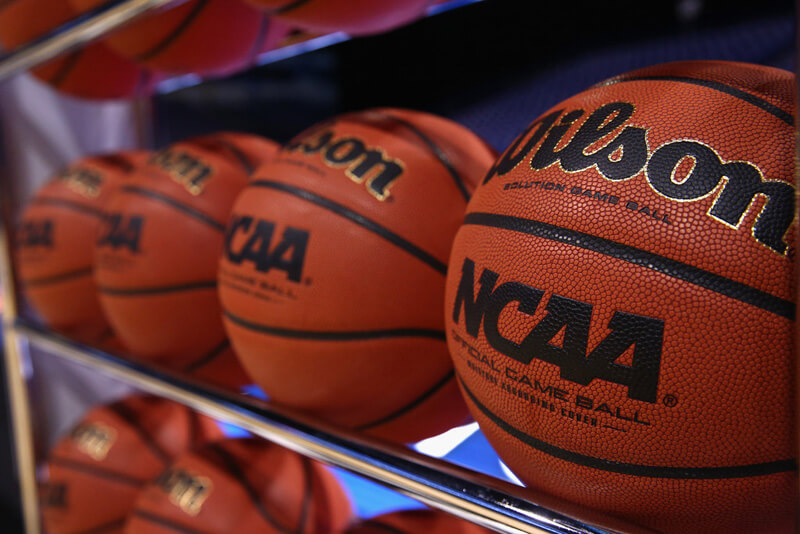NCAA to consider rules changes regarding flopping, foul limits and more

Late last week, the NCAA announced that it will consider rules changes on June 3 that would assess technical fouls on players who flop and also look at changing the foul limit within games.
Here’s the full outline released last week by the NCAA with all of the proposals that will be discussed:
The NCAA Men’s Basketball Rules Committee on Friday recommended officials assess technical fouls to players who fake being fouled, beginning in the 2021-22 season.
All rule proposals must be approved by the NCAA Playing Rules Oversight Panel, which is scheduled to discuss proposed men’s basketball rules changes June 3.
Committee members, who held a hybrid in-person/virtual meeting this week in Indianapolis, think adding the technical foul component is the next step in hopes of eliminating this tactic from the game.
Under this proposal, officials would no longer issue a warning on the first occurrence when they judge that a player is faking being fouled. Instead, officials would assess a Class B technical foul to the player each time they judge a player is embellishing being contacted, and the opposing team would receive one free-throw shot. The player whistled for feigning a foul would not be assessed a personal foul.
Examples of what officials will watch for include players involved in block/charge plays, players falling to the court despite not being contacted after field goal attempts, dribblers who bob their heads to simulate being contacted and players who act like they were the recipient of contact despite not being touched.
“After two years of using warnings, we didn’t feel like we were getting the results that we wanted,” said Tad Boyle, committee chair and head coach at Colorado. “We are trying to get flopping out of our game. We’re asking the officials to call them when they happen.”
Technology rules
The committee proposed allowing the transmission of live statistics to the bench area for coaching purposes. Conferences have experimented with live stats for the past two seasons and received positive feedback to move forward with the change.
The committee supported an experimental rule to allow teams to view live video and pre-loaded video on their bench during conference games only for the upcoming season should the conference submit a waiver request for the experimental rule.
If a conference chooses to use this experimental rule, it will be a conference’s decision as to what technology can be used within the parameters of the rule.
Teams would not be allowed to use the rule in nonconference games.
Teams competing in the 2021 National Invitation Tournament experimented with this expanded use of technology, and the feedback the rules committee received was positive.
“Every conference is probably at a different stage in their commitment to technology,” Boyle said. “We felt if every conference could do what was in the best interest of their league given their resources, we should allow it and get feedback from those who experiment with it. Technology isn’t going away.”
Experimental foul-structure rule
Committee members voted to recommend to the NIT board to use an experimental rule regarding foul structure during the 2022 NIT.
Players could be allowed a maximum of six fouls instead of the current five, in some scenarios, before being disqualified from a game. Under the experimental rule, any player called for four personal fouls in one half would be disqualified from playing the rest of the game.
For example, a player who picks up four fouls in the first half would have to sit out the rest of the game. If a player has one foul in the first half, he would be disqualified after picking up four in the second half.
If a player has three fouls in the first half, he would be disqualified after being called for three fouls in the second half.
The rationale behind the experiment is to offer players a chance to remain on the court if they happen to be called for two fouls in the first half. Most college coaches limit their players’ time on the floor in this scenario. Committee members want to see how the change to the foul structure could impact the game.
When the meeting started, Boyle wasn’t sure how those in the room would react to this idea. Some were intrigued, and some were reluctant. In the end, the committee decided experimenting with the rule was the way to move forward.
“It is an out-of-the box proposal,” Boyle said. “What is great about having a committee is you never know what will take off or what won’t. Certainly, we weren’t going to support it as a permanent rule without experimenting with it first.”
Timeouts
With a goal of having fewer stoppages in the game, the committee proposed that any timeout called by a team be designated as the media timeout provided that the media timeout has not already been used in that segment.
Men’s college basketball games generally have media timeouts after play is whistled dead for the first time under the 16-, 12-, eight- and four-minute marks of each half.
Under this proposal, if a coach calls a timeout at the 18-minute mark, it will serve as the under-16-minute media timeout. If either team calls a timeout under the 16-minute mark, it will serve as the under-12-minute media timeout. Under this scenario, the next media timeout wouldn’t occur until the under-eight-minute mark.
The committee thinks this will allow for more continuous action and help with the flow of the game.
Shot clock
The committee proposed allowing shot clocks to have tenths of seconds to be displayed next season. It would not be required, but schools could have them if they choose to use this optional rule.
Category: Media
Filed to:
